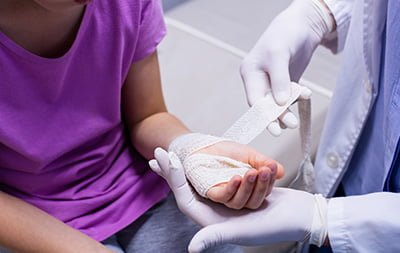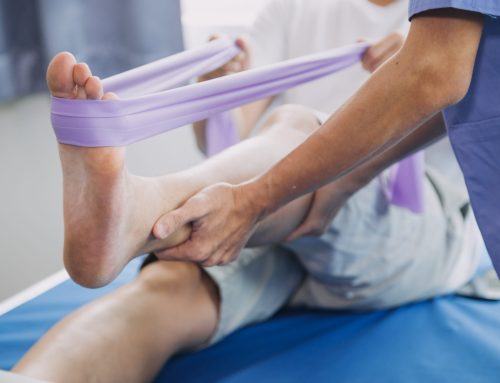The snowboarder takes a big jump, snags their edge on the way down, and lands forward on their hands. They brush it off, it’s not painful, and they want to finish out the day. Having an après-ski drink, their wrist is a bit sore but doesn’t feel broken or look bad, so they figure it must be a sprained wrist.

In the days following that fall, the wrist that felt tender at first swells a bit, but nothing alarming. Then discomfort in the thumb area begins to increase and hurt when trying to hold something like a fork or pen.
This is not a minor strained wrist, but rather a broken wrist, specifically a scaphoid fracture. This fracture is difficult to detect and diagnose but requires prompt treatment as delays can lead to arthritis and even bone death.
A small bone in the wrist that is vulnerable to injury and delayed fracture healing
In the winter, as more Canadians are playing outside, we see more and more scaphoid fractures. Every year in Canada, around 34,000 people sustain this break of a small bone in the wrist.
You’ve likely heard of carpal tunnel syndrome — pain that develops in the wrists from doing repetitive activities like typing or using a computer mouse. The carpal bones are the eight small bones in the wrist, consisting of two rows — one close to the hand and the other closer to the forearm. The scaphoid bone links these two rows together, sitting near the thumb, and making it the most vulnerable to injury.
The scaphoid bone has a unique, boat-like shape — “scaphoid” is also the Greek word for skiff or boat. Fractures of the scaphoid bone occur in 60 to 70 percent of all wrist bone breaks. When this small bone in your wrist is fractured, you may feel pain, but you may also feel few symptoms. Most do not look like a broken wrist. Usually, there is no bump on the wrist or difficulty using it, so most often it’s mistaken for a sprain. Symptoms you may feel include pain, tenderness, swelling, bruising, and difficulty gripping things or moving the wrist.
Delaying treatment can cause problems, so it’s important to get the doctor as soon as possible if you suspect this injury! The doctor will check how well the blood is flowing to the fracture and if there is any nerve damage in the wrist. Typically, an x-ray is used for diagnosis, but even x-rays don’t always show a scaphoid fracture. In this case, a CT scan or MRI may be needed. You may be referred to an orthopedic surgeon, a doctor who specializes in bone problems.
There are only a few tiny blood vessels that supply nutrients to the scaphoid bone and these can be damaged in a fracture. The bone needs a supply of blood to heal a fracture, which is why scaphoid fractures often take a long time to heal, sometimes up to a few months. The fracture often doesn’t heal well but if left untreated can lead to arthritis in the wrist.
How a scaphoid bone is broken
Boys and young men, aged 15 to 25 years old, are most likely to break a scaphoid bone. Not coincidentally, this demographic often loves more high-impact sports, like bike riding, roller skating and snowboarding.
Usually, this fracture results from a fall from standing height on to an outstretched hand. Falling this way causes all of the bodyweight to put pressure on the palms. Often a fracture of the radius bone – one of the large bones of the forearm — occurs as well.
The bone can also be broken in traumatic incidents where the hand and wrist receive a lot of pressure — like a car accident or a physical fight and when your wrist twists severely or is hit very hard.
Treating this tricky fracture
The goals of treatment are to heal the fracture, relieve pain, maximize function, and prevent arthritis. Minor scaphoid fractures can heal on their own in around six weeks in 90 percent of cases.
If the wrist is too swollen, your doctor may first require you to wear a splint. Otherwise, a cast is used to immobilize the thumb and wrist. If there is movement of the bone, the cast may need to stay on for eight to ten weeks. Regular checkups are good for checking how well the fracture is healing and your doctor can advise on how best to care for the splint or cast. If the ends of the bone have moved, you may need to get surgery, which may include screws or pins being inserted to hold the bone in place.
Non-union, when the fracture doesn’t completely heal within a normal period of time, occurs in five to ten percent of all scaphoid fractures. If the bone doesn’t heal well, you may have long-term pain, stiffness, or arthritis in the wrist.
While any fracture is healing, ensure you are eating a nutritious diet, not smoking, and limiting alcohol intake. A number of other factors also influence healing, including your age, activity level, other medical conditions and your use of the hand. It can also help to keep your broken wrist higher than your heart, use cold packs to reduce swelling, and pain medicine, like acetaminophen or ibuprofen, if you need it.
Using ultrasound therapy to heal a scaphoid fracture
Since a scaphoid fracture is more difficult for the body to heal on its own, due to low blood flow, low-intensity pulsed ultrasound has been shown to be very effective for these bone breaks.
Research has been done comparing the treatment of fresh scaphoid fractures between only wearing a cast and wearing a cast plus using ultrasound treatment for 20 minutes a day. They found that those patient’s fractures treated with the LIPUS devices were healed around 20 days earlier. Fractures healed with low-intensity pulsed ultrasound therapy healed in around six weeks, whereas traditionally treated fractures took more than two months.
Inline Medical Inc. provides the only subsidized rental of LIPUS devices to Canadians for easy, at-home treatment of fractures. We look forward to working with you to help heal a difficult scaphoid fracture.





Leave A Comment